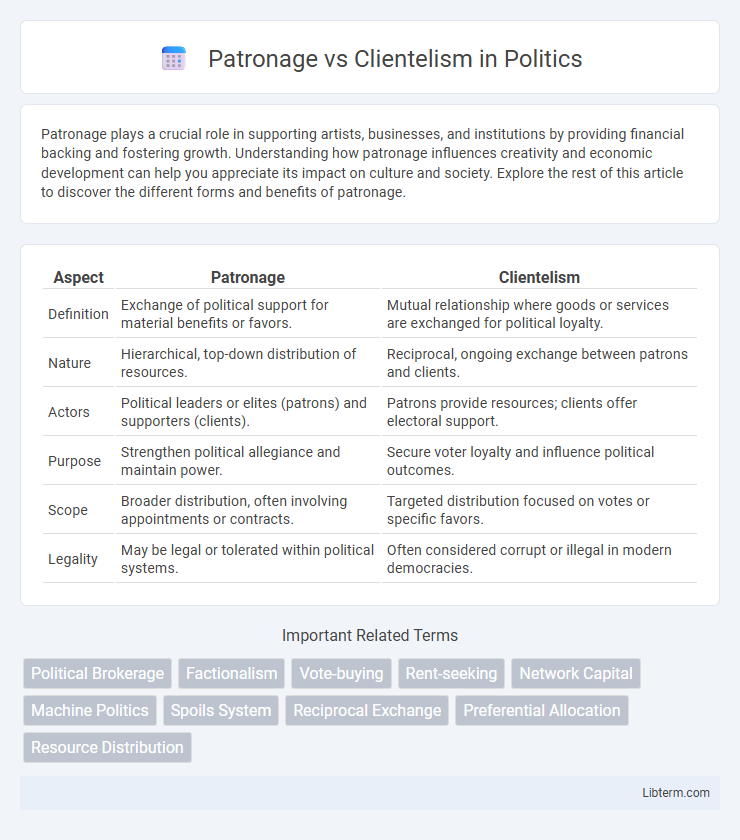Patronage plays a crucial role in supporting artists, businesses, and institutions by providing financial backing and fostering growth. Understanding how patronage influences creativity and economic development can help you appreciate its impact on culture and society. Explore the rest of this article to discover the different forms and benefits of patronage.
Table of Comparison
| Aspect | Patronage | Clientelism |
|---|---|---|
| Definition | Exchange of political support for material benefits or favors. | Mutual relationship where goods or services are exchanged for political loyalty. |
| Nature | Hierarchical, top-down distribution of resources. | Reciprocal, ongoing exchange between patrons and clients. |
| Actors | Political leaders or elites (patrons) and supporters (clients). | Patrons provide resources; clients offer electoral support. |
| Purpose | Strengthen political allegiance and maintain power. | Secure voter loyalty and influence political outcomes. |
| Scope | Broader distribution, often involving appointments or contracts. | Targeted distribution focused on votes or specific favors. |
| Legality | May be legal or tolerated within political systems. | Often considered corrupt or illegal in modern democracies. |
Defining Patronage: Origins and Evolution
Patronage originated in ancient societies as a system where patrons provided resources or protection in exchange for support and loyalty, evolving through political and social structures over centuries. It traditionally involves reciprocal relationships between powerful individuals and their clients, shaping governance and social hierarchies. Modern patronage systems reflect historical roots while adapting to contemporary political and economic contexts across various cultures.
Understanding Clientelism: Key Features
Clientelism is characterized by an asymmetric relationship where patrons provide targeted goods, services, or benefits to clients in exchange for political support, often rooted in personal loyalty rather than formal institutions. This system relies heavily on reciprocity, exclusivity, and hierarchical social structures, distinguishing it from broader patronage networks that may operate at more institutional or organizational levels. Understanding clientelism involves recognizing its role in perpetuating unequal power dynamics and its impact on democratic processes and resource distribution.
Historical Context: Patronage and Clientelism Across Eras
Patronage and clientelism have existed since ancient civilizations, exemplified by the client-patron relationships in Roman society where patrons provided legal and economic protection in exchange for political support. In medieval Europe, feudal lords exercised patronage by granting land and privileges to vassals, creating networks of loyalty and service. Modern political systems, such as those in Latin America and parts of Asia, continue to exhibit clientelistic practices where politicians distribute resources or favors to secure votes, reflecting a persistent historical pattern of reciprocal exchange.
Mechanisms of Patronage in Modern Politics
Mechanisms of patronage in modern politics include the strategic allocation of public resources, government jobs, and contracts to loyal supporters in exchange for political backing, ensuring a network of allegiance and influence. This system often operates through informal channels, leveraging personal relationships and political favors rather than formal institutions, thereby reinforcing the power of political elites. Patronage sustains political dominance by integrating beneficiaries into a dependency structure that prioritizes loyalty over meritocracy.
Clientelism in Practice: How Exchange Systems Operate
Clientelism in practice involves a reciprocal exchange system where patrons provide material benefits such as jobs, money, or services to clients in return for political support, often manifested through votes or loyalty. This system thrives on informal networks and personalized relationships, bypassing formal legal institutions and emphasizing face-to-face interactions. Clientelism is prevalent in various political contexts, undermining democratic accountability by perpetuating dependency and limiting equitable access to public resources.
Comparing Patronage and Clientelism: Core Differences
Patronage involves a reciprocal relationship where a patron provides tangible benefits like jobs or resources in exchange for political support, while clientelism extends beyond this by creating long-term, hierarchical networks of dependency and loyalty. Patronage is often transactional and short-term, whereas clientelism institutionalizes these exchanges within a broader system of social and political obligations. Understanding these distinctions highlights how patronage serves immediate interests, whereas clientelism reinforces enduring power structures through personalized exchanges.
Impacts on Governance and Public Administration
Patronage often leads to administrative inefficiency by prioritizing loyalty over merit, resulting in bureaucratic corruption and compromised public service quality. Clientelism entrenches unequal power structures through reciprocal exchanges, undermining transparent governance and fostering dependency of citizens on political patrons. Both practices erode institutional accountability, weaken democratic processes, and inhibit effective policy implementation in public administration.
Socioeconomic Drivers Behind Both Practices
Patronage and clientelism are driven by socioeconomic factors such as economic inequality, limited access to resources, and social stratification, which create dependency relationships between patrons and clients. In patronage systems, elites distribute material benefits like jobs or contracts to maintain political support, while clientelism often involves reciprocal exchanges of votes for goods or services, reinforcing social hierarchies. Both practices thrive in environments with weak state institutions and high economic insecurity, where personal relationships substitute formal governance mechanisms.
Global Case Studies: Regional Variations
Patronage and clientelism exhibit significant regional variations shaped by differing political landscapes, economic structures, and cultural norms across global case studies. In Latin America, clientelism often revolves around vote-buying and conditional service delivery, whereas Sub-Saharan Africa displays personalized patronage networks linked to ethnic affiliations and resource distribution. Southeast Asia presents a blend where patronage fosters elite consolidation, but clientelism persists through localized reciprocal exchanges, reflecting complex socio-political dynamics.
Reform Strategies: Reducing Patronage and Clientelism
Reform strategies for reducing patronage and clientelism emphasize strengthening institutional transparency and enforcing merit-based recruitment within public sector appointments to limit discretionary power. Implementing technology-driven systems such as e-governance and digital voting platforms enhances accountability and reduces opportunities for vote-buying and favoritism. Anti-corruption laws, independent oversight bodies, and civic education programs further empower citizens to demand fair governance and diminish clientelist networks.
Patronage Infographic

 libterm.com
libterm.com